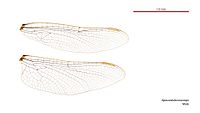Apocordulia
| Nighthawk | |
|---|---|
| Scientific classification | |
| Domain: | Eukaryota |
| Kingdom: | Animalia |
| Phylum: | Arthropoda |
| Class: | Insecta |
| Order: | Odonata |
| Infraorder: | Anisoptera |
| Genus: | Apocordulia Watson, 1980[2] |
| Species: | A. macrops
|
| Binomial name | |
| Apocordulia macrops | |

| |
Apocordulia is a genus of dragonflies in the superfamily Libelluloidea,[3] endemic to the Murray-Darling Basin in eastern Australia.[4]
Apocordulia is a monotypic genus with only one species, Apocordulia macrops,[5][6] commonly known as a nighthawk.[4] Apocordulia macrops is a medium-sized, dull coloured dragonfly with large eyes.[4] It inhabits inland rivers [7] and flies at dawn and dusk.[8]
Etymology
[edit]The word Apocordulia is derived from two words: apo from the Greek ἀπό meaning from or away, and Cordulia the genus of dragonfly. Tony Watson described the dragonfly genus Apocordulia as appearing different to the normal appearance of a Cordulia dragonfly.[2][9]
The species name macrops is derived from two Greek words makros (μακρός) meaning long, and ops (ὤψ) meaning eye, describing the long eye seam.[2][9]
Gallery
[edit]-
Female Apocordulia macrops wings
-
Male Apocordulia macrops wings
Note about family
[edit]Recent taxonomic research could not assign the genus Apocordulia to any family and it was placed incertae sedis within the superfamily Libelluloidea.[10]
Prior to this, Apocordulia had been considered to be part of one of several families: Austrocorduliidae, Synthemistidae or Corduliidae.[11]
See also
[edit]References
[edit]- ^ Dow, R.A. (2019). "Apocordulia macrops". IUCN Red List of Threatened Species. 2019: e.T14271959A59256543. doi:10.2305/IUCN.UK.2019-2.RLTS.T14271959A59256543.en. Retrieved 28 September 2024.
- ^ a b c d Watson, J.A.L. (1980). "Apocordulia macrops, a new crepuscular gomphomacromiine dragonfly from south-eastern Australia (Odonata: Corduliidae)". Journal of the Australian Entomological Society. 19 (4): 287–292 [287]. doi:10.1111/j.1440-6055.1980.tb00988.x.
- ^ "Genus Apocordulia Watson, 1980". Australian Faunal Directory. Australian Biological Resources Study. 2022. Retrieved 1 September 2024.
- ^ a b c Theischinger, Günther; Hawking, John (2021). The Complete Field Guide to Dragonflies of Australia (2nd ed.). Melbourne, Australia: CSIRO Publishing. p. 406. ISBN 9781486313747.
- ^ Paulson, D.; Schorr, M.; Abbott, J.; Bota-Sierra, C.; Deliry, C.; Dijkstra, K.-D.; Lozano, F. (2024). "World Odonata List". OdonataCentral, University of Alabama.
- ^ "Species Apocordulia macrops Watson, 1980". Australian Faunal Directory. Australian Biological Resources Study. 2022. Retrieved 1 September 2024.
- ^ Theischinger, Gunther; Endersby, Ian (2009). Identification Guide to the Australian Odonata (PDF). Department of Environment, Climate Change and Water NSW. p. 241. ISBN 978-1-74232-475-3.
- ^ Watson, J.A.L.; Theischinger, G.; Abbey, H.M. (1991). The Australian Dragonflies: A Guide to the Identification, Distributions and Habitats of Australian Odonata. Melbourne: CSIRO. ISBN 0643051368.
- ^ a b Endersby, I. (2012). "Watson and Theischinger: the etymology of the dragonfly (Insecta: Odonata) names which they published". Journal and Proceedings of the Royal Society of New South Wales. 145 (443 & 444): 34–53. ISSN 0035-9173 – via Biodiversity Heritage Library.
- ^ Dijkstra, Klaas-Douwe B.; Bechly, Günter; Bybee, Seth M.; Dow, Rory A.; Dumont, Henri J.; Fleck, Günther; Garrison, Rosser W.; Hämäläinen, Matti; Kalkman, Vincent J.; Karube, Haruki; May, Michael L.; Orr, Albert G.; Paulson, Dennis R.; Rehn, Andrew C.; Theischinger, Günther; Trueman, John W.H.; Van Tol, Jan; von Ellenrieder, Natalia; Ware, Jessica (2013). "The classification and diversity of dragonflies and damselflies (Odonata). In: Zhang, Z.-Q. (Ed.) Animal Biodiversity: An Outline of Higher-level Classification and Survey of Taxonomic Richness (Addenda 2013)". Zootaxa. 3703 (1): 36–45. doi:10.11646/zootaxa.3703.1.9. hdl:10072/61365. ISSN 1175-5334.
- ^ Theischinger, Günther; Hawking, John (2006). The Complete Field Guide to Dragonflies of Australia. Collingwood, Victoria, Australia: CSIRO Publishing. p. 366. ISBN 978 0 64309 073 6.



